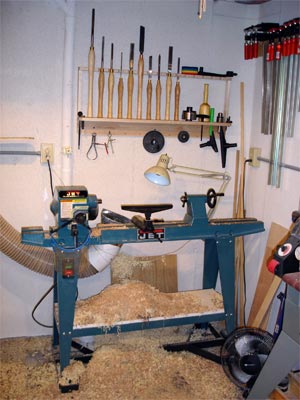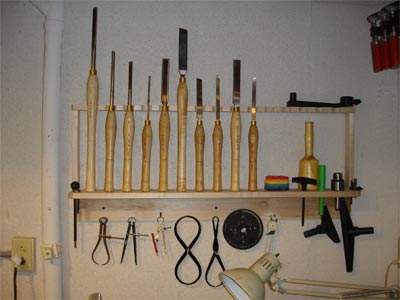
Jet 1236 Lathe (1999ish)

The Jet 12" variable speed wood lathe. The head pivots 90 degrees for outboard bowl turning. I still haven't yet mastered this tool, but I'm enjoying learning. So far I've turned a bunch of pens, some bad looking spindles (mallets, table legs, etc), and a few really embarrassing bowls. It seems as though a woodworker could dedicate him/herself to turning and have plenty of interesting work.
In my previous shop I needed to have all my tools mobile, so I added an HTC mobile base to the lathe. I wouldn't recommend that to anyone else unless your equipment has to be easy to move. The mobile base does a great job at making the tool move-able (is that a word?), but it makes the lathe a bit more unstable than if it were planted directly to the floor. In my current shop I have a dedicated spot for turning so I was able to stop using the mobile base.
I've made a few modifications to the lathe to make it more user-friedly. First was to raise the lathe a few inches to bring the spindle centerline even with my elbow height. I also added bags of play sand to the base as ballast to keep the lathe more stable and fight vibration. And I also added a new low speed detent to reduce the minimum speed of the lathe to a bit under 500 rpm. That's an easy modification that's highly recommended, as it makes it a bit safer for the initial turning of unbalanced bowl blanks. These three mods were easy to make and have made a huge difference in the usability of the lathe. You can read step-by-step instructions for making the speed modification on this page, and here's a pic of the raised lathe with the ballast:

This lathe suits me well enough. As I get more confident and competent with turning I can see that someday I'll want to upgrade to something a bit bigger and beefier, but for now the 1236 meets my needs. I've heard several people have problems with the banjo breaking under a heavy catch, but mine has survived in tact. I have had to replace the point of the live center, but that only cost me a few dollars.
If you're new to turning be sure to budget money for all the accessories you'll need. You'll need to buy a bunch of HSS turning tools (spindle gouges, bowl gouges, roughing gouges, skew chisels, parting tools, and scrapers), and you'll need to have a grinder (and setup jigs) to keep the tools sharp. Before you know it you'll be lusting after a chuck and chuck jaws, and there's all sorts of other turning doodads and gizmos to spend your money on. The lathe is often the smallest investment in the wood turning hobby.
Here are a some other pics that show the lathe (prior to the ballast and height change) partially buried in shavings and the wall rack I built to keep the tools close at hand.


© Copyright 2006 Chris Billman